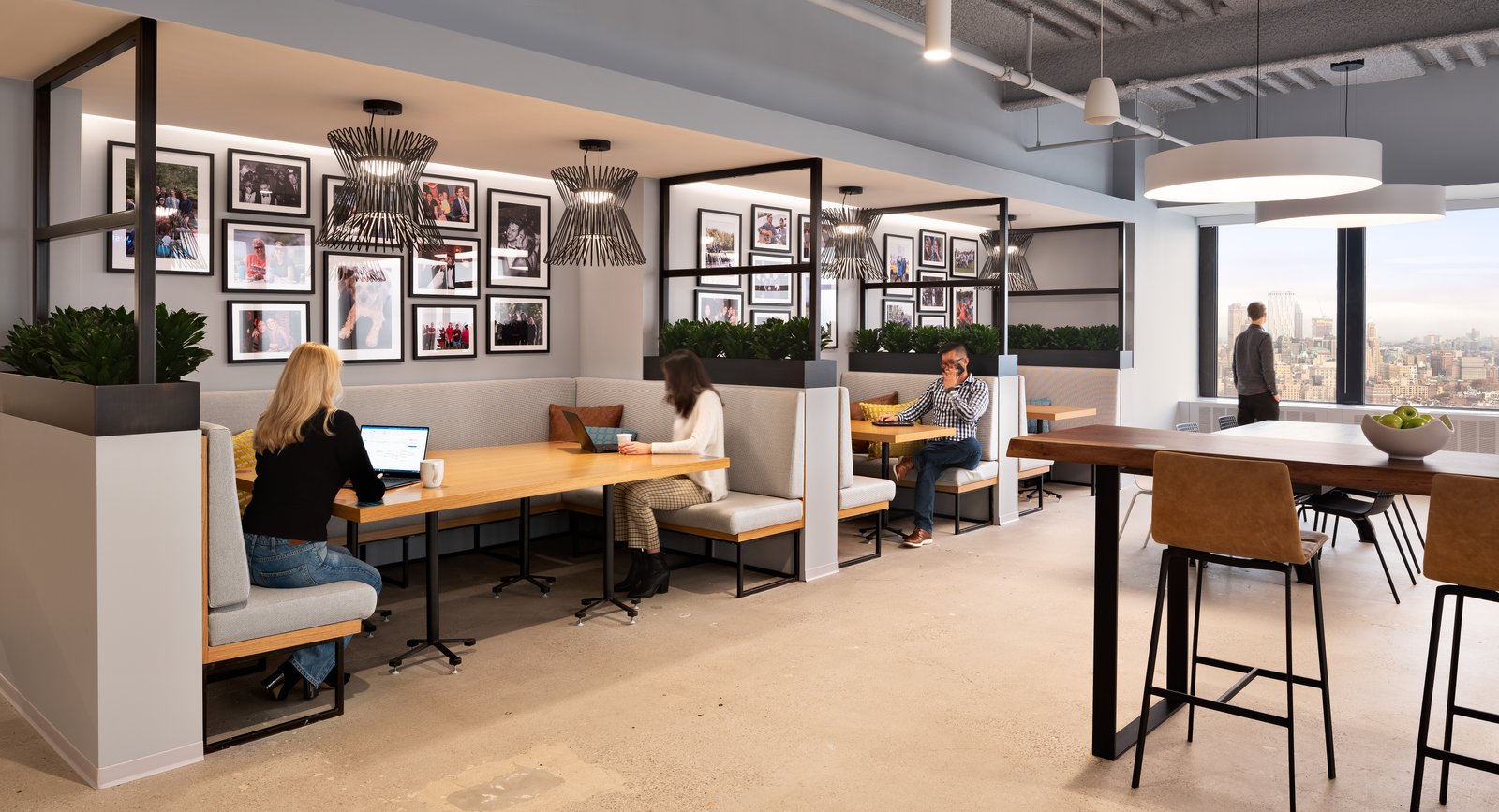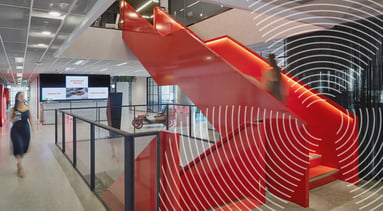What's next: The latest strategies to rethink, recreate, and reengage your workplace

In a recent webinar, we were joined by workplace experts from Facebook, Verizon, JPMorgan Chase, and RAISE to tackle some of corporate real estate’s biggest questions. From accelerating trends, to the employee experience, to office designs and maximizing productivity, they shared their insights and cutting-edge ideas for the future workplace.
Meet our experts:
| Courtney Mezinis, Executive Director, Global Real Estate National Portfolio Strategy Corporate & Retail, Verizon | Terry Raby, Global Workplace Design Director, Facebook |
| Jen Nguyen, Executive Vice President & Head of Workplace, RAISE | Albert DePlazaola, Global Director of Strategy, Unispace |
| Ray Quartararo, Head of Global Planning, Design & Construction for Global Real Estate, JPMorgan Chase & Co. |
Remote working is here to stay, but does that mean the office is becoming irrelevant?
Pre-pandemic, utilization studies told us 30-40% of office space across any market is left unutilized. Now, we’re seeing that workforces want to retain some form of remote working and flexibility up to three days per week. From those sentiments, the office could be unoccupied up to 80% at any given time, causing leadership to question the need for the office at all.
Our panels’ thoughts? Offices will be relevant, but the focus will be different.
“People are really itching to come back. They miss human interaction, they miss collaboration. I think people want flexibility going forward. And we're all figuring out how that will be built in.” - Ray Quartararo, JPMorgan Chase & Co.
“…What people come in for we feel will be very different. That's why we're really incorporating a lot of hospitality into our approach.”
- Courtney Mezinis, Executive Director, Verizon
What trends are coming to the forefront as the purpose of the office is redefined?
Wellness
In recent years, wellness has become a hot topic for the workplace. However, the pandemic has highlighted the different struggles teams are experiencing outside of the physical aspects of health. Wellness now encompasses connecting, mentoring, and diversity, equity and inclusion.
“I think the idea of wellness has to extend beyond the workplace because actually work is extending beyond the workplace” - Albert DePlazaola, Unispace
One of Facebook’s real estate initiatives, FCS (Facilities, Culinary, and Security) provides their teams with physical and mental wellness support through activities like designing their home office spaces and innovatively connecting with different groups in different locations to work on projects together.
“It all ties in with the health of the employee – the wellness, diversity inclusion and mentoring, and the feeling of connecting to someone or to the office.”
- Terry Raby, Facebook
Building hygiene
As people start coming back into the office, they want to know their environment is safe. From sanitization cards to touchless technology, staff expect transparency about what companies are doing to make the office a safe place.
Amenities
If staff are going to be asked to come back into the office, they want the perks that go with it. Verizon’s internal leadership poll showed a focus on informal spaces, café-like environments, and app-ordering for meals. In other words, hospitality is emerging as a front running trend in the future office.
Bridging the hybrid gap
Parity between home and office workers is going to be a big focus for companies in the future. How can they create an equal playing field for their entire workforce? Jen Nguyen of RAISE says, “it comes down to choice." Providing all staff with access to the same amenities, whether it’s workout programs, collaboration tools, or co-working passes, gives them the ability to benefit from the incentives they want to use.
How can the workplace and work experience help address diversity, equity and inclusion (DE&I)?
The pandemic has caused companies to re-examine and readdress DE&I and how workplace design ties into creating a more equal environment.
Facebook approaches this through three pillars: People, places, and processes.
This extends past the teams to the community, incorporating diversity in processes with partners, vendors, and consultants.
JPMorgan’s focus on DE&I and accessibility looks at intentional and programmatic changes like mandating the use of diverse providers across their portfolios. They have also included a full suite of accessibility standards in their design guidelines and across their entire global portfolio.
Ray Quartararo sums it up nicely, "It's about the people and the process and the spaces that we build.”
How can office design support the next normal?
Companies are still gathering intel to see how people will come back to the office, with one of the big questions being will the post-Covid-19 world demand something different?
Verizon has built logic into creating plans to return to the office, bucketing staff into full-time return, full-time remote, and various hybrid options based on surveys. Scheduling tools are helping with capacity planning and providing recommendations for when it makes sense to bring teams together.
JPMorgan believes their people will come back to the office in a significant way, and flexibility will be a major component to this. Some design changes include offices with moveable and touchless functionality, and collaboration spaces fitted with technology. These “stage sets” are designed to be adopted across multiple businesses and environments.
Facebook is currently operating with two working models, one being remote, the other in office with flexibility. Their focus is on the experience and providing tools and resources that allow their staff to be productive and collaborative in their working environment.
We asked our attendees what they thought:
51% of our attendees believed staff will continue working remotely 2-4 days per week. So, we know the workplace has a role, it will just be redefined.
What is technology’s role in the future workplace?
With work’s biggest experiment pushing nearly all workforces in a completely remote setting, companies have had to quickly enable their staff with the technology they needed to do their jobs effectively. This shift to virtual communication and engagement has caused leaders to rethink technology’s role in the workplace and in workplace design.
For JPMorgan, technology will be used in two ways:
- Tech enabled workplaces – Fitting offices with flexible, mobile, and collaborative technology like webcams, headsets, movable smart boards, and more to support the new “desktop experience”.
- Data led strategies – Planning using data to measure utilization, productivity, satisfaction, and various environmentals like indoor air quality.
“I think technology will be a big aspect in what’s happening in the actual workplace as well as how we plan in the future.” - Ray Quartararo
RAISE sees technology as solutions to help companies come back and build a better workplace. This includes providing experiential services and visitor management.
“Technology is helping companies create a seamless employee experience, to the point that it's almost touchless.” - Jen Nguyen
The challenge will be balancing a tech enabled experience with the in-person connectivity staff have been missing.
So, what’s next for the workplace?
Throughout our conversation with our thought leaders, they discussed how the workplace is and will continue to adjust and evolve to support the changing needs of their people. But what’s the next big thing? We asked our panelists, and to put it simply, technology.
Courtney thinks 5g technology and advanced building systems are going to be a big focus going forward from a wellness perspective, but also around sustainability initiatives, which are huge. Building automation, censoring, and the like are going to be major priorities going forward to help reduce our carbon emissions.
Our environment has created an ecosystem based on using technology like iPhones, Amazon, and Uber. Technology is and will continue to change our everyday lives. This has permeated into how companies are approaching office design. Ray noted, “we're all building offices for three generations of people right now where the youngest generation expects something very different when they come to the office and the older generation is benefitting from that.”
Lastly, Jen predicts AI will play a bigger role in how we interact with peers and colleagues. From holograms to advanced technology telling us the optimal points connect based on various algorithms and data sets, our experiences will be completely virtual and touchless.
Want to hear more?
Download the infographic
Access the on-demand recording.


